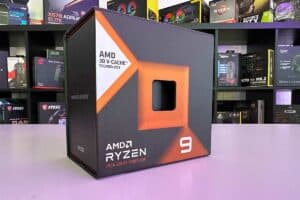Best CPU cooler for i9-12900K
Exploring the best CPU cooler for Intel’s Core i9-12900K, and why exactly we need CPU coolers.

WePC is reader-supported. When you buy through links on our site, we may earn an affiliate commission. Prices subject to change. Learn more
The i9-12900K was regarded as the fastest gaming CPU in the world before the 5800X3D and 12900KS came to steal its thunder. This CPU was intel’s 12th generation flagship, sporting a new never-before-seen technology across its CPU cores. The 12900K is basically the best of the 12th gen, without the special edition. This CPU is packed full of power, but all this power creates heat. Heat in a PC is the enemy of performance.
The Intel Core i9-12900K features ARM’s LITTLE.big technology to split its CPU cores into P-cores and E-cores. Make no mistake, the 12900K still needs one beefy cooler to counteract its massive 241W Max boost TDP, but it could have been a lot higher had it not been for this new split-core technology. Without further ado, let’s find the best CPU cooler for 19-12900K. If you’re looking for the best CPU coolers of 2022, or the best LGA 1700 CPU coolers, we have you covered.
Today’s best cooling deals
- Corsair iCUE H115i Elite CAPELLIX XT Liquid CPU Cooler – Save 28% now!
- ASUS TUF Gaming LC II 360 ARGB AIO Liquid CPU Cooler – Save 13% now!
- NZXT Kraken 280 RGB CPU Liquid Cooler – Save 20% now!
- Thermaltake TH360 ARGB Sync V2 CPU Liquid Cooler – Save 20% now!
- Thermaltake TH120 ARGB – Save 25% now!
- Razer Hanbo Chroma RGB All-In-One Liquid Cooler – Save 18% now!
- IN WIN Luna AL120 Triple Pack ARGB LED Fan – Save 12% now!
- MSI MAG CoreLiquid C240 CPU Liquid Cooler – Save 12% NOW!!
- Lian Li UNI Fan SL120 V2 RGB Black Triple Pack with Controller – Save 18% NOW!
- Lian Li Galahad II LCD 360 AIO – Save 5% now!
How do CPU coolers work?
Before we get started, it’s important that we understand the inner workings and core principles of CPU cooler operation.
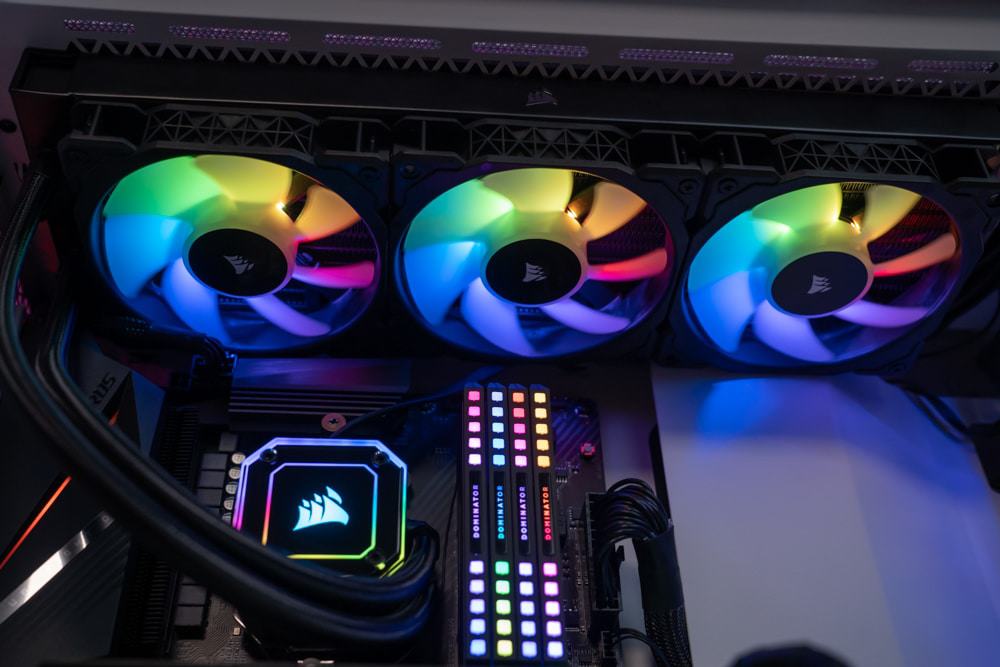
CPU coolers are pretty complicated in terms of physics, but they aim to fulfill one single purpose and that’s to negate as much heat produced by the CPU as possible. CPU coolers achieve this in a few ways.
There is unfortunately some basic physics to understand here if you want to know how CPU coolers work. Heat dissipation is performed via three main methods, conduction, convection, and radiation. Most CPU coolers use at least one of these methods at some stage throughout the cooling cycle.
Heat moves from the CPU to the cold plate, then through the heat pipe, then the heat is transferred to the heatsink. This is where, with the aid of a fan, the heat is dissipated into the free space or air around the heatsink.
This is a very simple explanation of how CPU coolers work, and we have one with much more detail in our “Best CPU cooler for Ryzen 9 5900X” article.
Things to consider
There are a few things to consider when opting for a new CPU cooler, and these are mainly TDP, spacial limitations, and socket type.
CPU TDP
TDP is the very reason we’re installing a CPU cooler in the first place, TDP stands for thermal dynamic power and is the maximum amount of heat a component can output at its maximum load under standard operating conditions.
A more powerful CPU may contain more cores or threads, and be clocked at a higher speed, for example, the addition of these features increases power consumption, creating more wasted energy (this is what’s known as TDP).
When any electrical component operates, it wastes some of its energy as thermal or heat energy. This is a natural occurrence and cannot be stopped, all we can do is integrate IHS’ onto the CPU die to allow a more efficient transfer of heat between CPU and cooler. The more efficient this process gets, the better we will become at pulling heat out of the CPU. Unfortunately not eliminate heat entirely.
Make sure the TDP dissipation statistic on the CPU cooler you’re planning on getting exceeds the TDP of your CPU, especially if you plan on overclocking.
Socket
When selecting any CPU cooler it’s important you make sure that the cooler fits the CPU socket on your motherboard. This isn’t usually a problem with today’s CPU coolers as most of them come with native compatibility for almost all sockets, and if they don’t they’ll usually contain a backplate. However, if you’re opting for an older cooler whilst owning a newer socket, it would be wise to check the compatibility information whenever you think of making a purchase.
All of our CPU coolers today fit the LGA 1700 socket, as this is the designated CPU socket of the 12900K.
Spacial requirements and case configuration

This is an important aspect to consider as you definitely want your CPU cooler to fit into your PC case without any obstruction.
Air cooler
If you’re opting for an air cooler, you just need to ensure that all of the clearances check out. What we mean by this is that you need to make sure the heatsink clears the RAM and the CPU cooler isn’t too tall for the side panel of the PC. If you’re really unlucky, and you have a behemoth CPU cooler, you might be disgusted to find the CPU cooler obstructs the top 16X PCIe slot, where you’d usually install the GPU.
AIO cooler
An AIO cooler, however, is another matter. AIOs require much less room around the CPU socket but require a radiator of varying size to be mounted somewhere in the PC case. This means you’ll need clearance between the motherboard, RAM, and PC case in order to mount the radiator. And you’ll need to make sure that the PC case supports the width of the radiator.
AIR vs liquid cooling
Both air and liquid cooling are viable options when it comes to PC cooling, but one is superior in terms of performance.
Air cooling
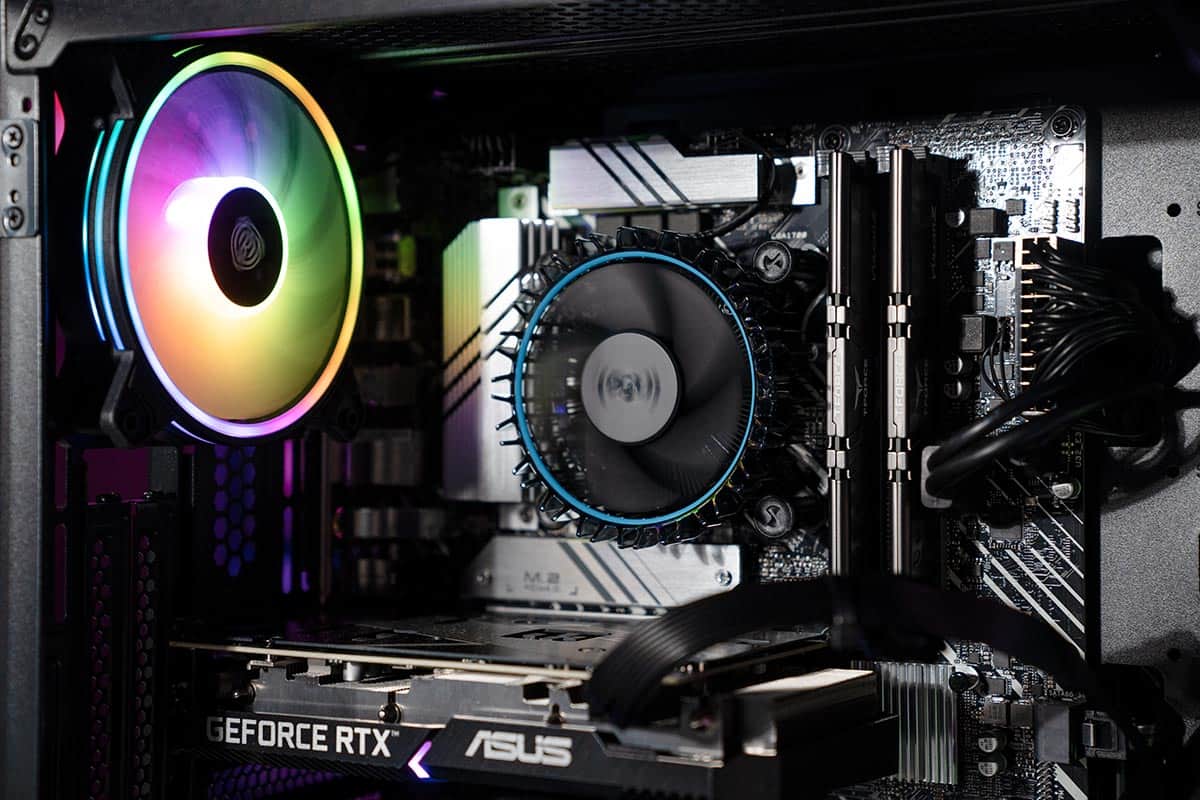
Air cooling has been around since the inception of computers, and even the most advanced forms of water cooling still use forms of air cooling to dissipate heat away from components.
There’s not a whole lot to say about air coolers, other than the fact they are some of the cheaper options on the market. Some high-end air coolers can even compete with smaller liquid coolers.
Air coolers are easy to install and maintain, and their simplicity is one of their strengths.
Liquid cooling
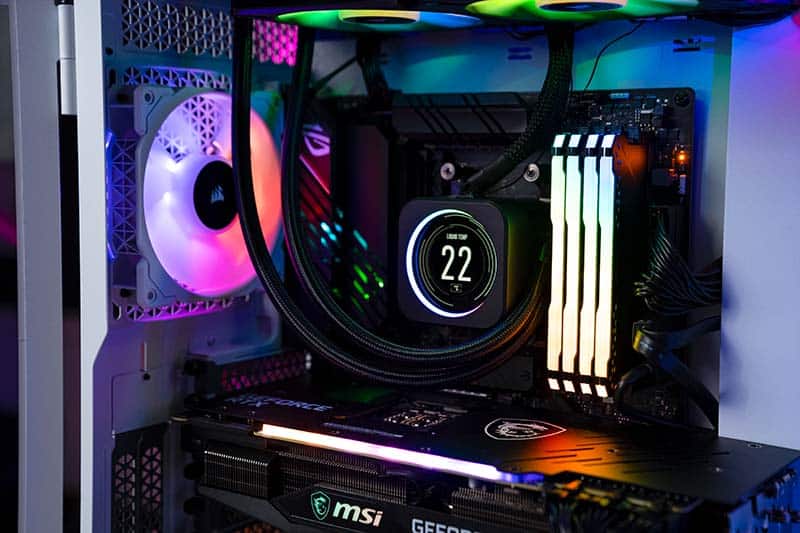
Liquid cooling comes in a couple of different forms, AIOs and custom loops. AIO coolers are all the goodness of custom loops rolled into one neat little package, whereas custom loops can be as complex or as simple as you want them to be. For our purposes right now though, we’ll just be focusing on AIOs
AIOs
AIOs consist of a water block, a built-in pump, transport tubes, a radiator, and a few fans – if they’re included. These components put together comprise a mid-level AIO water cooling system.
AIOs are closed, meaning you cant open them up to access the pump or any of the internals. This enclosed design means that AIOs are less susceptible to dust build-up and damage around the pump area but still suffer the same dust build-up on radiators and fans – depending on your airflow configuration.
AIOs are generally less expensive than custom loops, but they can be much more expensive than a good air cooler. There are a lot of AIOs out there and they all come in different shapes and sizes, some can even feature LCD screens mounted onto the water block.
Despite the price increase, AIOs do generally perform significantly better than most air coolers.
The best cooler for i9-12900K
Here we will list the three CPU coolers we feel are the best choice for the i9-12900K CPU.
Asus ROG RYUJIN II 360 CPU Cooler
Asus ROG RYUJIN II 360 CPU Cooler

CPU Block Dimensions
78.15 x 87.5 x 81 mm
Socket Support
Intel: LGA 1150, 1151, 1152, 1155, 1156, 1200, 1366, 2011, 2011-3, 2066 AMD: AM4, TR4*
Fans
3x Noctua NF-F12 InductrialPPC 2000 PWM Fans
Features
3.5″ Full Color LCD Screen
- LCD Screen
- High Performance
- Aesthetically, one of the best looking AIOs on the market
- Expensive
- More affordable options that perform similarly
The ASUS ROG Ryujin II is one of the most visually pleasing AIO coolers on the market, mostly thanks to its huge pump and vivid, industrial-looking LCD screen.
This model is available in both 240 and 360mm variants, giving builders with different form factor cases some flexibility regarding the size.
The main feature of the Ryujin II is the addition of an LCD screen, which allows any image, GIF, or system information to be displayed. The LCD screen has full in-built AIDA64 support, meaning you can display current system state information in real-time on the 3.5″ full-color screen if you so wish, but if you want to display your favorite cat gif, we promise we won’t judge you.
The Ryuijin ii also features 380mm of sleeved tubing comprised of thick rubber, to add durability and improve the visuals over the duller, more plain tube designs out there.
All in all, we have a beefy, efficient radiator that will provide your 12900K with all the cooling it needs, and the inclusion of a hefty, high-flow water pump means your CPU will never be in need of more water to help keep it cool.
You can check out our full Ryujin ii review here if you’re interested in learning more.
Corsair iCUE H150i Elite Capellix Liquid CPU Cooler
Corsair iCUE H150i Elite Capellix XT Liquid CPU Cooler

Item Dimensions LxWxH
15.63 x 4.72 x 1.06 inches
Brand
Corsair
Cooling Method
Water
Noise Level
34.1 dB
- Quiet Running Volume – This system should rarely break 36dBA.
- RGBs – bright and punchy, these RGBs will breathe new life into your case.
- Pump Design – A split-flow copper cold plate and a ton of micro-skived fins enable you to push your CPU to the limit.
- Price – You may have to liquidate your assets to afford this liquid asset.
- Installation – The fans can be difficult to screw into place.
Corsair is known for its excellent design, performance, and aesthetics. The H150i Elite Capellix is no exception.
The cooling potential of the H150i matches most of its competition, and there are other similar variants to cater to a variety of case sizes and form factors. This 360mm option is perfect for the new high-end Core i9 CPUs, including the 12900K, and the RGB makes for a welcome addition to improve the design and feel of the cooler.
Speaking of aesthetics, few coolers do it as well as the Capellix. From the pump to the fans, it is incredibly well designed, and it can provide all the cooling a high TDP CPU needs without being too in your face or over the top.
You can also purchase an upgrade kit for this CPU cooler. This upgrades the AIO to feature a full-color LCD screen over the head of the water block, as opposed to the logo toasting RGB diffusion plate, to display gifs, pictures, and a whole host of animations made by Corsair. All this also includes the option to display system information, allowing you to monitor temps in full real-time.
There is also a separate LCD variant of this AIO cooler with upgraded fans, you can find it here: Corsair H150i LCD review.
Noctua NH-D15
Noctua NH-D15
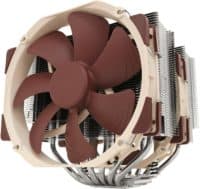
Type
Air
Max RPM
1500 RPM
Max Noise
24.6 dB
Dimensions
(H)165 x (W)150 x (D)150 mm
- Solid thermal performance
- Excellent acoustic performance
- User-friendly mounting system
- Outstanding build quality
- Comes with (2) 140mm fans
- Relatively expensive
- Hefty size
This Noctua cooler stands up against its competition, and it even gives some lower-end liquid CPU coolers a run for their money under certain scenarios.
The design is certainly very Noctua with the brown color we’ve all come to … love, but it’s the cooling potential that matters most when opting for a CPU cooler.
The size can be an issue if you’re wanting to build in a smaller form factor case, with extra clearance between RAM and case side panel needed for the two giant heatsinks and accompanying 140mm fans. Noctua does offer a much smaller ‘S’ variant, for gamers with more spacial constraints, without compromising too much on cooling efficiency.
With a maximum noise level of 24.6dB and with a max RPM of 1500, this really is one of the best and quietest air coolers on the market.
Other useful links
Final word
All of the coolers on our list today are going to be perfectly suited to your i9-12900K, the only restraints are situation and cost. If you’re looking for a smaller and less expensive cooler, then your best bet will probably be the Noctua air cooler. However, if you’re willing to dig deeper in your wallet you will find comfort in the loving arms of cooling efficiency. The two AIO CPU coolers will make a perfect addition to your setup and are definitely the best CPU cooler for i9-12900K CPUs.
We hope you found our article useful.








